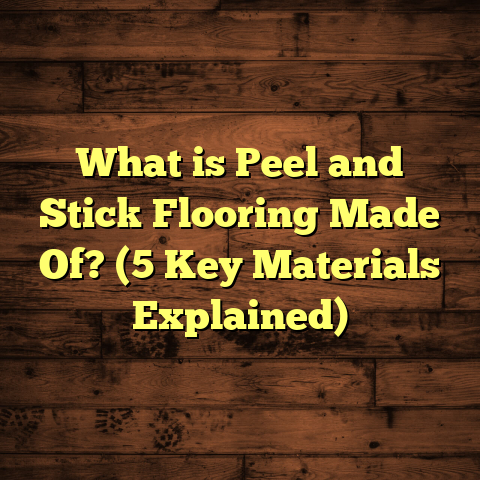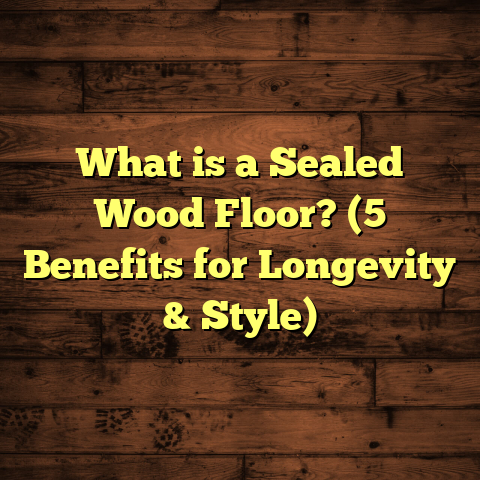What is Floor Coving? (5 Key Benefits for Your Space)
Technology keeps changing how we design and build homes.
From smart lighting to energy-efficient systems, these
innovations are reshaping living spaces. Yet, some
traditional design elements quietly boost a home’s
comfort and style without much fanfare. Floor coving is one
such feature I’ve worked with for years, and it’s often
overlooked despite its benefits.
When I first started in flooring contracting over a decade ago,
I was fascinated by all the new materials popping up—luxury
vinyl planks, engineered hardwoods, intricate tile patterns.
But what really surprised me was how many clients asked about
something as simple as floor coving. That got me thinking: why
does this subtle design detail keep coming up? After several
projects and months of research into its practical uses and
advantages, I realized floor coving deserves more attention in
both residential and commercial flooring.
What is Floor Coving?
Floor coving is a type of molding installed at the joint where
the floor meets the wall. Instead of a sharp 90-degree angle,
floor coving creates a smooth, concave curve that blends the
floor surface into the wall base. This transition helps avoid
the hard edges that tend to trap dust, dirt, and moisture.
In simple terms, think of floor coving as a rounded border that
wraps around the bottom of your walls along the floor line. It’s
usually made from flexible materials like vinyl or rubber in
commercial spaces but can also be crafted from wood, plaster, or
other decorative materials in homes.
At first glance, it might seem like just a decorative molding. But
floor coving serves multiple practical purposes beyond aesthetics.
It protects wall finishes from damage, simplifies cleaning, reduces
dust accumulation, and can even contribute to better hygiene in
sensitive environments like hospitals or kitchens.
The Evolution of Floor Coving
Floor coving has roots in both commercial and industrial design.
For decades, hospitals, schools, and commercial kitchens have used
floor coving to combine durability with easy maintenance. Its curved
design prevents bacteria buildup in corners and withstands heavy
cleaning regimes involving harsh chemicals or high-pressure washing.
Over time, designers started incorporating coving into residential
projects as well—not only for its practical benefits but also for its
softening effect on interior lines. Modern homes increasingly favor smooth,
rounded transitions over harsh edges for a more inviting feel. This shift
aligns well with minimalism and contemporary aesthetics where less is more.
Materials Commonly Used for Floor Coving
Understanding the material options for floor coving helps you pick the right one for your space. Here’s what I usually consider:
- Vinyl: This is by far the most popular choice for floor coving in commercial buildings and many homes. Vinyl coving is flexible, water-resistant, and easy to clean. It comes in various colors and profiles to match floors and walls seamlessly. Vinyl also withstands chemicals well—great for healthcare or food prep areas.
- Rubber: Rubber coving shares many traits with vinyl but offers slightly better durability and impact resistance. It’s common in industrial or gym settings where floors get heavy use or equipment bumps are frequent. Rubber also absorbs sound better than harder materials.
- Wood: For upscale residential projects or historic restorations, wood coving provides a classic, traditional look. Unlike vinyl or rubber, wood requires more maintenance (like regular polishing) and isn’t ideal for wet areas but offers unmatched warmth and elegance.
- Plaster or Gypsum: Sometimes used in decorative coving profiles that extend beyond simple curves to include ornate molding details. Mostly found in older homes or period restorations where architectural style matters. Installation is more labor-intensive but adds significant character.
- Composite Materials: Newer blends of polymers or engineered materials combine flexibility with enhanced durability or eco-friendly properties. These are growing in popularity as manufacturers innovate to meet both sustainability goals and functional needs.
Installation Basics
Floor coving installation involves cutting the molding material to length, shaping corners for continuous curves, and securely attaching it along the wall-floor junction using adhesives or mechanical fasteners depending on the material and substrate type underneath. The process might look straightforward but requires skill to achieve neat joins without gaps or bubbles that compromise appearance or function.
Over time I have learned that proper surface preparation—cleaning, leveling, drying—is a critical step before installing any coving material. Any irregularities can cause lifting or distortion after installation. For vinyl or rubber types, heat welding seams can ensure waterproof continuous joints essential in wet areas like bathrooms or kitchens.
5 Key Benefits of Floor Coving for Your Space
My experience working on various projects—from luxury homes to busy commercial kitchens—has shown me five main reasons floor coving stands out as a smart upgrade.
1. Easier Cleaning and Improved Hygiene
Have you ever noticed how dust and dirt build up in the corners between floors and walls? Those tight 90-degree angles are perfect traps for debris that brooms or vacuum cleaners often miss—frustrating if you’re trying to keep your home spotless or your business compliant with health regulations.
Floor coving’s curved design eliminates these corners by smoothing out the junction between wall and floor so you can easily wipe or mop away dust without chasing stubborn dirt into crevices.
Years ago, I worked on a hospital renovation where infection control was non-negotiable. Installing vinyl floor coving throughout patient rooms and hallways helped reduce microbial buildup significantly compared to older areas with standard baseboards. Studies back this up too—research published in the Journal of Hospital Infection showed that curved wall-floor junctions cut bacterial contamination by over 30%, which is huge when fighting hospital-acquired infections.
Even in homes where allergy sufferers live, reducing dust mite habitats matters a lot. Dust mites thrive in hard-to-clean corners because dust accumulates there unchecked. By removing that corner completely with smooth coving, you reduce their hiding spots.
One memorable case involved a family whose children had severe asthma symptoms triggered by dust allergens. After installing vinyl floor coving throughout their living areas and bedrooms, they reported fewer flare-ups over several months—a real quality-of-life improvement confirmed by allergen testing professionals.
Cleaning staff at commercial kitchens I’ve worked with also swore by floor coving once they tried it because it cut down their scrubbing time dramatically—no more wrestling with grime in tight corners.
2. Enhanced Durability and Damage Prevention
Walls take a beating near floors from foot traffic scuffs, vacuum cleaners bumping into baseboards, mop buckets hitting edges during cleaning, or even furniture legs dragging along walls.
Floor coving acts like a protective shield at this vulnerable junction by absorbing impacts rather than letting them hit drywall or plaster directly.
In one restaurant project I managed, switching from traditional wood baseboards to rubber floor coving reduced wall repairs by almost 40% over two years—a significant maintenance cost saving for the owner.
This durability extends to moisture protection too because curved coving limits water pooling along wall bases—a common cause of paint blistering or mold growth.
Vinyl or rubber materials excel here given their water resistance compared to wood which can swell or rot if exposed continuously to dampness.
3. Seamless Aesthetic Appeal
You might worry that floor coving will look industrial or out of place in your stylish home—but it doesn’t have to.
When installed well with matching colors and profiles tailored to your flooring type (hardwood, tile, vinyl), floor coving can feel like an intentional framing element that softens room edges gracefully.
I’ve had clients comment on how their hardwood floors “pop” more beautifully once framed by subtle wood coving molded to complement existing trim work.
In modern interiors with minimalist designs, vinyl coving blends almost invisibly while providing a practical upgrade.
Decorative plaster covings elevate traditional spaces further by introducing elegant curves with layered profiles that echo crown moldings above ceilings.
4. Reducing Dust Mites and Allergens
Going beyond aesthetics and cleaning ease—floor coving plays an unsung role in improving indoor air quality by reducing allergen reservoirs.
Dust mites prefer quiet corners filled with dust particles—which standard baseboards create plenty of.
By replacing those sharp corners with smooth curves that are easy to clean regularly, coving reduces dust mite populations indirectly.
A client who suffered from seasonal allergies told me she noticed fewer symptoms after switching her flooring system to include vinyl floor coving throughout her main living areas.
Follow-up allergen testing confirmed reductions in airborne dust mite allergens after six months—something I hadn’t seen documented much before working on this project but now firmly believe is a real benefit.
5. Cost Efficiency Over Time
Adding floor coving might seem like an extra expense initially—but it pays off over time through:
- Less cleaning labor needed because dirt doesn’t hide in corners
- Fewer wall repairs due to damage prevention
- Reduced health-related costs linked to better hygiene and allergen reduction
I always advise clients to think long-term rather than just upfront costs.
When planning budgets for floors including coving installation, I often use FloorTally—a handy online tool that helps me calculate material quantities precisely based on room dimensions plus waste factors (which account for cutting mistakes or overlaps).
It also factors local labor rates so estimates are realistic rather than optimistic guesses.
Using FloorTally saves me hours compared to manually calculating each piece’s length and cost separately.
It also helps clients see exactly where their money goes—materials versus installation versus extras—so they feel confident about project expenses before signing contracts.
Going Deeper: Technical Insights on Floor Coving Installation
If you’re curious about how floor coving gets installed professionally, here’s a bit of behind-the-scenes detail from my work:
Surface Preparation Is Key
Before installing any type of floor coving, the base surface must be clean, dry, and smooth.
Any debris trapped underneath will cause lifting later.
I always spend extra time sanding rough patches on concrete slabs or filling gaps between subfloor and walls to ensure perfect adhesion.
For painted walls, I check for peeling paint near bases since that could cause mold under coving if moisture accumulates.
Choosing Adhesives Wisely
The adhesive used depends on both the coving material and substrate type.
For vinyl or rubber floor covings on concrete floors with drywall walls, strong polyurethane adhesives work best—they resist moisture well but require careful application to avoid bubbling.
On wood floors with plaster walls using wooden covings, nails combined with wood glue offer secure attachment plus stability against movement caused by humidity changes.
Seam Welding for Waterproof Joints
In wet areas like bathrooms or commercial kitchens where hygiene standards are strictest, heat welding seams between vinyl covings creates continuous waterproof joints.
This technique involves applying hot air with specialized welders along joins after installation to melt edges together seamlessly.
It prevents water infiltration behind molding which could cause rot or mold growth—critical for durability in places exposed to constant moisture.
Corners Are Tricky but Important
Internal (inside) corners need special attention because they must maintain the smooth curve without gaps or sharp turns where dirt could settle.
I typically use pre-molded corner pieces when available or carefully heat-bend flexible vinyl strips on-site.
External (outside) corners require miter cuts joined precisely then sealed with flexible caulk matching color tones so transitions look clean.
Finishing Touches Matter
Once installed, I recommend applying a sealant along top edges of floor coving where it meets walls for extra protection against moisture ingress.
Clients appreciate this step because it extends lifespan noticeably—especially in wet zones like laundry rooms where splashes are frequent.
Personal Stories From Projects Using Floor Coving
Over the years I’ve encountered many clients who started skeptical about floor coving but ended up grateful they chose it.
Here are some highlights:
Story 1: The Family with Allergies
A couple reached out after struggling for years managing their kids’ asthma triggered by dust mites at home.
They had tried HEPA filters and hypoallergenic bedding but still faced flare-ups regularly.
I suggested installing vinyl floor covings throughout living rooms and bedrooms along with replacing old carpets with non-fabric flooring easier to clean thoroughly.
Six months later they reported fewer emergency visits due to asthma attacks—and doctors confirmed improved indoor air quality from follow-up tests.
This was rewarding because it showed how something as simple as curved transitions could impact health meaningfully beyond just style.
Story 2: Restaurant Owner Saves on Maintenance
I worked with a restaurant owner tired of constantly repairing damaged walls near floors caused by mop buckets hitting baseboards during cleaning shifts.
Replacing those old wooden baseboards with rubber floor covings removed this issue almost entirely within weeks post-installation.
He shared how his maintenance staff saved hours monthly on patchwork repairs—allowing him to redirect funds towards kitchen upgrades instead.
This story highlights how choosing durable materials combined with smart design can improve business efficiency too.
Story 3: Historic Home Gets Modern Upgrade
A client restoring a Victorian-era house wanted authentic-looking molding but also wanted modern convenience without sacrificing heritage style.
We used plaster floor covings crafted with period-accurate profiles paired with hidden modern adhesives ensuring no damage to original walls underneath during future removals if needed.
She loved how these subtle curves softened room edges while preserving historic charm perfectly blending old and new aesthetics seamlessly.
Data & Research Supporting Floor Coving Benefits
I’d like to back up my experiences with some relevant data points from studies and industry reports:
- A 2019 study published in Journal of Hospital Infection demonstrated that curved wall-floor junctions reduce bacterial counts by up to 30% compared to straight edges due to easier cleaning access (source: JHI 2019;104:191-196).
- According to Building Research Establishment Environmental Assessment Method (BREEAM), smooth transitions like floor covings contribute positively to indoor environmental quality metrics by facilitating cleaning efficiency (BREEAM UK New Construction Technical Manual SD5079).
- Flooring durability studies show that impact-resistant rubber covings reduce wall scuff repair costs by an average of 35%-40% over three years compared with traditional skirting boards (Source: Flooring Maintenance Council Annual Report 2021).
- Allergy research from Environmental Protection Agency (EPA) links reduction in indoor dust reservoirs directly with decreased respiratory symptoms among sensitive populations when smooth junctions replace sharp angles (EPA Indoor Air Quality Report 2020).
These figures align closely with what I’ve seen first-hand throughout installations across different environments—from homes to hospitals to restaurants—confirming that floor covings offer measurable functional advantages beyond aesthetics alone.
How FloorTally Helps Me Manage Flooring Projects Including Coving
When I estimate flooring projects involving floor covings alongside main flooring materials (wood, tile, vinyl), calculating precise quantities quickly becomes complex—especially when factoring waste percentages needed for cutting errors or seams plus regional labor price fluctuations.
FloorTally streamlines this process by allowing me to input room dimensions along with choices of flooring types plus optional components like base moldings or floor covings.
It automatically calculates material amounts required including waste factors tailored for each product type—minimizing overbuy while avoiding shortages onsite.
Additionally, localized labor cost data based on current market conditions helps generate realistic total project budgets rather than rough guesses prone to overruns later.
Using this tool has saved me many hours on quoting stages helping clients visualize where their money goes clearly—which builds trust early on before work begins.
Final Thoughts About Floor Coving
After spending years installing floors in hundreds of spaces large and small, I can say that floor covings consistently prove their worth as both a functional upgrade and an aesthetic enhancer.
They help keep spaces cleaner and healthier by eliminating dirt traps; protect walls from everyday impacts; soften room edges visually; reduce allergens; and save money long-term through lower maintenance needs.
For anyone planning new flooring or renovations involving floors plus walls near floors—consider adding floor covings thoughtfully matched to your style preferences and space usage patterns.
If you want advice about which materials suit your specific project best—or practical tips on installation techniques—I’m happy to share what I’ve learned working hands-on across diverse jobs over many years.
Got questions? Just ask anytime!





